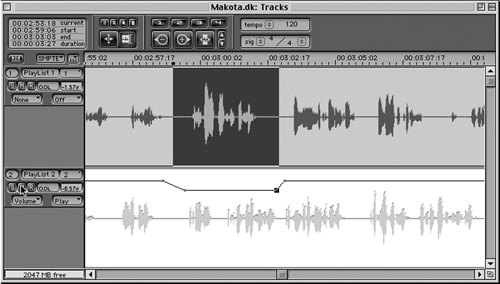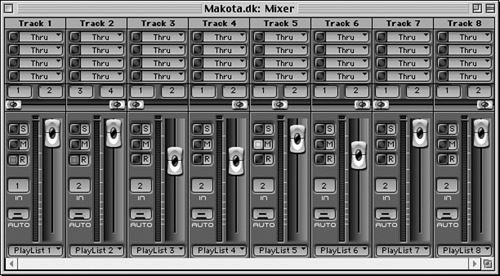
The Track window is where you view, arrange and edit audio files along a timeline. Figure 3 shows the Track window with part of the upper track highlighted for editing. The lower track is set to show mix automation (more on this later). You can bounce multiple tracks down to one or two tracks, or use “virtual mixing” to create mixes that are hundreds of tracks deep thanks to Deck’s 999 virtual tracks. Although many radio projects do not need more than a mono VO track, two music tracks for a stereo bed, and a couple of tracks for sound effects, it’s nice to know that Deck has the capacity to add as many tracks as your hardware is capable of playing. On my system, I allocated 200MB of my system’s total RAM to Deck and was able to run comfortably with as many as 32 real-time tracks with no “choking” or crashing.

The Mixer window (see figure 4) allows you to record directly into any of Deck’s playback tracks, and gives you control of level, pan, and effects inserts, plus the usual Record, Mute, and Solo functions. Deck provides one VU meter for each track, located right next to the fader. The meters are not referenced or calibrated beyond color coding the segments, with the bottom third green, the middle third yellow, and the top segments red to signify overs. In addition, a resettable red clip indicator lights and stays lit if you’ve recorded any overs. Each mix channel has four effects inserts, which are located at the top of the window. To choose an effect you simply click and hold on one of the insert labels (all shown as THRU in the illustration) and pick an available effect. The button to the left turns that effect on and off.
EDITING
Deck has two modes for selecting and editing audio, Range and Object, and you choose between them using the two large buttons on the top right of the Track window. Range mode lets you select any section of any waveform on any track, and slice or copy that piece to create or alter a region. Most of the edits you will perform in Range mode pertain to defining pieces of an audio track as regions, cutting and pasting small portions of longer audio regions, and fading or cross-fading sections of audio regions. Object mode lets you select groups of regions and move those regions for the purposes of editing, effects spotting, or general organization. Object mode is designed for wholesale arrangement of existing regions, and general trimming and placement.
Deck offers seven fade styles for in-points and out-points. They range from a simple straight-down linear fade at the end of a selected track to a gentle curved fade range. Two of these fade types can be combined to give you literally dozens of choices. The owner’s manual does give good illustrations and suggestions of different fade envelopes to obtain specific results.
